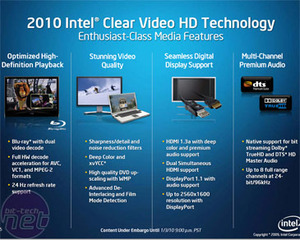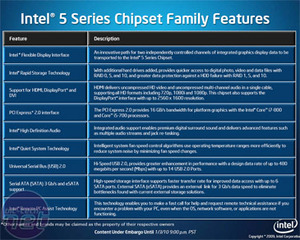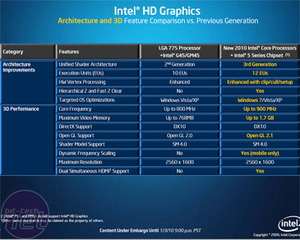Intel GMA HD Graphics: Is It Any Good?
Manufacturer: IntelIt goes without saying that enthusiasts and gamers give Intel a tough time for its integrated graphics, and for the most part it's entirely justified: Intel has never produced integrated graphics worth gaming with, and driver updates occur more infrequently than we get sun in London.
On the upside though, since the more recent X4500HD for LGA775 Core 2 CPUs (which was developed from the X3500), Intel finally had graphics that could cope well with video playback: real h.264 acceleration at HD resolutions and with later updates, proper 24Hz support. The best part about it was Intel's awesome Clear Video that clearly exceeded the competition in terms of picture quality and had features like de-interlacing and inverse telecine that actually worked.
Intel's newly launched Clarkdale CPUs - the Core i3 and lower end Core i5 models - feature integrated Intel graphics, branded GMA HD. The graphics chip is architecturally interesting; it's actually a 45nm chip which contains, along with the graphics, the memory controller, PCI-Express and DMI link to the PCH too. It connects to the 32nm CPU die directly via an internal QPI link, precisely the kind of modular design Intel (and AMD) have been talking about.
The GMA HD is not just a 45nm die shrink of Intel's GMA graphics, it's also been beefed up slightly with an extra two unified shaders, bringing the total to twelve. That really don't seem like much when we compare it all to the table above, however there are additional tweaks elsewhere:
Intel is very clearly concentrating on its video playback performance, not its gaming. Most of its graphics slides in the presentation here were geared that way, with only a dip into The Sims and World of Warcraft. Admittedly very popular games, but what we here at bit-tech want to play? Not really. This is also why Intel doesn't push its graphics harder than 12 shaders and add more support than DirectX 10 - that's all the shader horsepower it feels it needs for casual gaming and video postprocessing. Remember, that Intel aims for the broadest markets and on the technical side, there's a transistor budget and CPU TDP to think of.
On the subject of TDP - desktop Clarkdale CPUs have a single GPU clock speed, whereas mobile GPU parts can actually reduce in clock speed to just 133MHz to save power, and even TurboBoost if there's more graphics than CPU required. Apart from picking the premium chips for mobile parts, this is also partly why their TDP is a lot lower.
Back to the support for video though and from the slides Intel has ticked almost every box we can think of. There's full Blu-ray support with picture-in-picture and HDMI 1.3a that includes the native 36-bit deep colour and bit-streaming of HD audio formats from Dolby and DTS via a protected audio path. 24Hz support is rolled over from the X4500HD, and likewise there's the excellent de-interlacing, noise reduction and full-HD decoding of AVCHD, VC1 and MPEG-2 codecs.
I can already hear those seriously interested in building a Media PC diving for your wallets.
Intel also claims support for DisplayPort with audio, but we've nothing yet in our lab to test this, and we've also yet to see any motherboard or portable device with dual HDMI ports too. Intel did firmly state Clarkdale can run two independent digital outputs, however on many motherboards we see the usual digital switcher that means you have to choose between DVI and HDMI. We'll have to keep an eye on this one because we suspect the second digital output is only available by using an external TMDS at extra cost.
Also note that a dual-link DVI connection is not included in its spec, so it's limited to 1920x1200 via DVI and by extension, HDMI. 2,560 x 1,600 is only available via DisplayPort, which means GMA HD is likely incompatible with almost all 30in displays currently and previously available on the market.
So it's not suitable for workstations with ultra-high resolution monitors - forgivably as it is a mainstream product and not technically designed for that market, and besides, you could have a pair of 24in or -27in models instead.

MSI MPG Velox 100R Chassis Review
October 14 2021 | 15:04














Want to comment? Please log in.